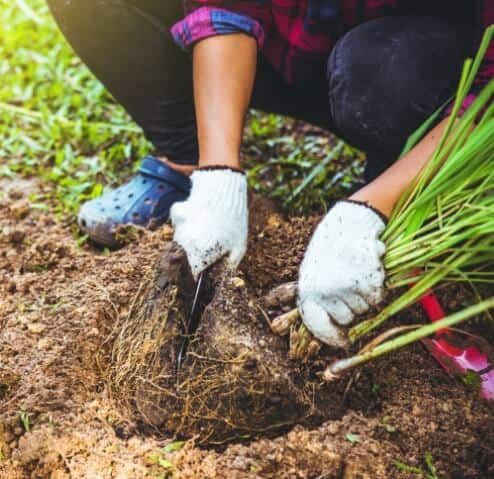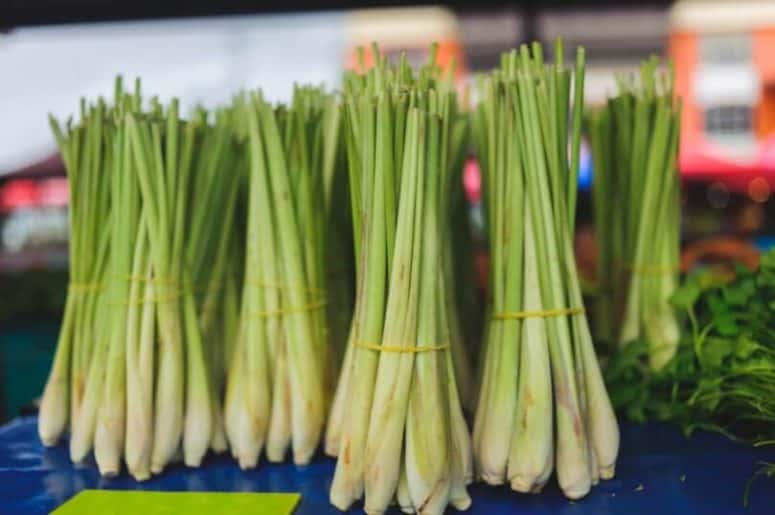Hailing from the tropical regions of Asia, particularly the Indian subcontinent, lemongrass is a herb known for its distinct lemony flavor, reminiscent of ginger’s warmth.
In my mother’s kitchen, lemongrass is an essential herb that complements a wide array of hot dishes. Whether you opt for dried or fresh lemongrass, it adds a delightful touch to your culinary creations.
Considering its versatility and delightful taste, why not grow lemongrass yourself? The good news is that lemongrass is among the easiest herbs to cultivate, making it a perfect choice for aspiring gardeners.
Lemongrass Varieties
Before embarking on the journey of planting lemongrass, it is beneficial to familiarize yourself with the various lemongrass varieties available. These varieties exhibit different characteristics and may vary in terms of suitability for your specific hardiness zone.
Ornamental Lemongrass (Cymbopogon citratus)
One of the widely encountered lemongrass varieties is the ornamental lemongrass, also known as oil grass or West Indian lemongrass.
This particular type of lemongrass is a perennial herb that thrives in hardiness zones 10 and 11. While the roots can tolerate colder temperatures down to USDA zone 8, the plant may enter a dormant state during harsh freezes and resume growth in the following season.
Citronella (Cymbopogon nardus)
Lemongrass is renowned for its mosquito-repellent properties, particularly the variety known as citronella lemongrass. This particular type of lemongrass is also referred to as nard grass or mana grass.
Citronella lemongrass thrives in USDA hardiness zones 10 to 12. However, it should be noted that it may face challenges in surviving excessively wet winters.
Java Citronella (Cymbopogon winterianius)
The name “Java citronella” derives from its origin on the island of Java in Indonesia. This variety of citronella lemongrass is characterized by its gracefully arching leaf stems, which showcase hues of yellow or reddish-purple.
When it comes to hardiness, Java citronella lemongrass can thrive in USDA zones 9A through 11. However, in cooler regions, it tends to behave as an annual herb, completing its life cycle within a single growing season.
East Indian Lemongrass (Cymbopogon flexuosus)
East Indian Lemongrass, commonly referred to as Malabar grass, is celebrated for its distinct pungent fragrance and warm aroma emanating from its stems and leaves.
This particular variety of lemongrass is a perennial herb that thrives in USDA hardiness zones 9 to 11. However, in cooler climates, it can be grown as an annual herb in a spacious container, allowing for mobility and flexibility in cultivation.
Jama Rosa
Jama Rosa lemongrass is known for its ability to withstand and tolerate cooler temperatures compared to other varieties. It is a fast-growing type of lemongrass that can reach considerable heights, making it a hybrid cross between different lemongrass types.
Sugandhi
Sugandhi lemongrass stands out among other lemongrass varieties due to its notably high oil content.
Lemongrass Cultivation

Having familiarized yourself with the different varieties of lemongrass, it is now time to delve into its cultivation process, ranging from soil preparation to propagation methods. Let’s dive right in!
Soil Requirements
Lemongrass thrives in loamy and nutrient-rich soil, making it beneficial to incorporate organic matter like compost or manure to enhance soil fertility.
While it prefers loamy soil, it’s crucial to avoid overwatering to maintain a sandy and adequately moist soil environment for lemongrass growth.
Sun Requirements
When it comes to lighting requirements, lemongrass thrives in full sun exposure, even in hot weather conditions. Providing your lemongrass with a minimum of six hours of direct sunlight is optimal for its growth.
It’s important to avoid excessive shading of your lemongrass, as it can lead to sparse growth and attract pests. Ensuring sufficient sunlight will contribute to its overall health and vitality.
Hardiness
It’s important to keep in mind that lemongrass is a tropical and perennial herb, thriving in zones 9-10 where hot temperatures are prevalent.
However, lemongrass is sensitive to cold weather and frost. Taking precautions to protect it during winter is crucial.
Before the outdoor temperature drops to the 40s, it is recommended to bring your lemongrass indoors in a pot to ensure its well-being throughout the colder months.
Water
Unlike some other herbs that can tolerate drought conditions, lemongrass has different needs. Lemongrass is not drought-tolerant and requires consistent moisture to thrive.
To ensure the health of your lemongrass, it is important to keep the roots consistently moist. Water the plant when the top layer of soil has dried out, providing regular hydration to prevent drying out.
Fertilizer
To achieve optimal growth and health of lemongrass in your home garden, nitrogen fertilizer is recommended. A slow-release 6-4-0 fertilizer can be applied during the growing season to provide the necessary nutrients.
In addition to nitrogen fertilizer, using manure tea can supplement the plant with essential trace nutrients. This organic liquid fertilizer can help promote robust growth and overall plant health.
Mulch
In certain situations, using mulch is beneficial for various plants, including certain herbs. Mulch, which can be made of materials like sawdust or compost, serves multiple purposes such as reducing evaporation, regulating soil temperature, preventing weed growth, and improving soil quality.
When it comes to lemongrass, mulching is indeed recommended. Applying a layer of mulch, around 3 inches thick, helps retain soil moisture and enhance soil fertility. This is particularly important as lemongrass is not well-suited to withstand drought conditions.
Pruning
To promote healthy growth in your herb garden, pruning is an essential practice. Lemongrass, being a perennial herb, can benefit from regular pruning throughout its lifespan.
When it comes to pruning lemongrass, you have the flexibility to do it at any time. However, a recommended approach is to shear the stems back to about 6 inches in length at the end of winter, allowing them to rest during the colder months. As the weather starts to warm up, your lemongrass will quickly regenerate and resume its vigorous growth.
Division
An additional method for propagating lemongrass is through root division. When performing this technique, it is important to ensure that you leave approximately an inch of root attached to the plant.
To successfully divide the lemongrass, start by trimming the blades to a height of about two inches. This step helps balance the plant’s growth and prepare it for the division process.
Best Methods to Grow Lemongrass
Discover the top and highly recommended techniques for cultivating lemongrass in your own home!
Stem Cutting
One of the most popular and effective ways to grow lemongrass is through stem-cutting, which involves planting a stem that has been cut from an existing lemongrass plant.
To propagate lemongrass through stem-cutting, start by making a few-inch cut at the top of the stalk, being careful not to remove the tough outer layer that houses the stem. This layer is where new leaves will emerge.
Place the stem cutting in a jar of water and ensure it receives ample sunlight.
Root Cutting
Another way to propagate lemongrass is through root cutting. Here’s how you can do it:
Keep in mind that rooting lemongrass using this method may take approximately three weeks. Start by placing the roots of the lemongrass bulb downwards in a container filled with about 2.5 inches of water.
To prevent the growth of fungus, it’s important to change the water every day or every two days. After around two or three weeks, you should see the rooted lemongrass growing to a length of 2.5 or 5 centimeters.
Once the roots have developed, you can transplant the lemongrass into your garden, making sure to provide it with the recommended soil, water, and sunlight conditions.
Growing from Seed
Certainly, it is possible to cultivate lemongrass from seeds. To begin, plant the seeds in punnets during the spring season. You can water them regularly or consider incorporating eco-seaweed to promote healthier growth.
The seeds will typically take around 14 to 25 days to germinate. Once the seedlings have established themselves, transplant them into smaller containers and allow them to grow to a height of approximately 15 to 20 cm.
How to Care for Lemongrass

When it comes to growing herbs, it is important to be prepared for the various aspects of care involved. This encompasses tasks such as managing pests, addressing potential diseases, understanding propagation methods, harvesting the herbs at the right time, and knowing how to store them properly. By being attentive to these aspects, you can ensure the health and productivity of your herb garden.
Pests/Disease
While lemongrass generally repels insects, it can still attract some pests that may pose a threat to its well-being. However, the aromatic properties of lemongrass often act as a natural deterrent. Spider mites can be a concern, particularly during winter months.
Furthermore, certain regions may experience issues with rust fungus affecting lemongrass plants. It’s essential to be vigilant and take necessary measures to address these potential challenges to ensure the health and vitality of your lemongrass.
Propagating Lemongrass
Propagating lemongrass is a straightforward process due to its robust growth. The exciting part is that you can divide and harvest lemongrass simultaneously, as both tasks involve digging.
Keep in mind that each lemongrass leaf is connected to a slender bulb-like base, which also holds the roots. Each of these bulb-like bases has the potential to become a new lemongrass clump.
Exercise caution while dividing the lemongrass, as the bulbs can be delicate and prone to breakage when handled with a spade or hoe. Take care to preserve the bulbs intact during the division process.
Harvesting Lemongrass
Lemongrass comes in various varieties, each with its unique uses and benefits. Therefore, it is perfectly acceptable to harvest lemongrass even when the plant is still in its early stages.
When it comes to culinary purposes, it is best to wait until the lemongrass has matured before harvesting. However, harvesting young lemongrass is not a problem either. You can use it to make flavorful teas or infuse it into your broths and dishes.
To harvest lemongrass, start by removing individual stalks from the clump, ensuring you take the entire stalk along with the roots. Use a hand towel to firmly grip the stalk and gently pull it away. Next, peel off the tough outer layer of the stalk, revealing the tender white portion. Finally, chop the stalk into the desired size for your culinary needs.
Storing Lemongrass

Now it’s time to store our freshly harvested lemongrass!
To start, make sure your lemongrass is completely dry before storing it. You can wrap it loosely in a breathable material, such as a paper towel or a breathable bag, ensuring that there is still some airflow. Place the wrapped lemongrass in the refrigerator, where it can stay fresh for several weeks.
As for dried lemongrass, it’s best to store it in airtight containers, away from light and heat. This will help preserve its flavor and aroma. Unlike fresh lemongrass, dried lemongrass can withstand being stored in a cool, dark place for a longer period of time.